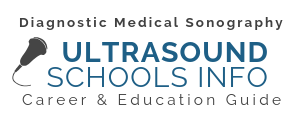Sonographers are highly trained medical professionals, and their salaries are reflective of the skill level required for the job. They are among the highest paid of all medical technicians. High earning potential combined with great employment outlook makes sonography a popular choice.
How Much Will You Earn?
 The table below shows the national median annual salaries for sonographers across the earnings spectrum. Experience level, education, and credentials can affect how much you might earn. Conditions in your area may vary.
The table below shows the national median annual salaries for sonographers across the earnings spectrum. Experience level, education, and credentials can affect how much you might earn. Conditions in your area may vary.
| Bottom 10% | National Median | Top 10% Earners |
|---|---|---|
| $61,430 | $81,350 | $107,730 |
| $29.54/hour | $39.11/hour | $51.70/hour |
(Bureau of Labor Statistics, National Occupational Employment Statistics Survey, May 2022. Salary earned may vary depending on location, level of education, credentials earned, and employer. )
An Associate of Science degree in DMS in the minimum amount of education required to enter the job market. Graduates with a Bachelor’s degree in medical sonography and their RDMS credential may be able to ask for a higher starting salary. Dual concentrations in areas such as cardiac and vascular sonography may increase employment opportunities.
Sonographer’s Wages Across the Country
| State | Annual Mean Wage |
|---|---|
| Alabama | $60,240 |
| Alaska | $87,770 |
| Arizona | $89,980 |
| Arkansas | $70,370 |
| California | $114,480 |
| Colorado | $92,610 |
| Connecticut | $94,930 |
| Delaware | $80,640 |
| District of Columbia | $94,800 |
| Florida | $74,110 |
| Georgia | $75,940 |
| Hawaii | $105,850 |
| Idaho | $82,910 |
| Illinois | $86,540 |
| Indiana | $75,510 |
| Iowa | $76,050 |
| Kansas | $82,920 |
| Kentucky | $69,580 |
| Louisiana | $64,860 |
| Maine | $80,110 |
| Maryland | $89,910 |
| Massachusetts | $95,310 |
| Michigan | $70,560 |
| Minnesota | $89,610 |
| Mississippi | $66,430 |
| Missouri | $81,210 |
| Montana | $85,810 |
| Nebraska | $78,400 |
| Nevada | $89,330 |
| New Hampshire | $82,990 |
| New Jersey | $87,010 |
| New Mexico | $79,780 |
| New York | $89,340 |
| North Carolina | $75,610 |
| North Dakota | $74,410 |
| Ohio | $77,250 |
| Oklahoma | $72,810 |
| Oregon | $101,850 |
| Pennsylvania | $75,500 |
| Puerto Rico | $26,760 |
| Rhode Island | $96,400 |
| South Carolina | $75,070 |
| South Dakota | $65,110 |
| Tennessee | $71,280 |
| Texas | $78,440 |
| Utah | $87,720 |
| Vermont | $89,840 |
| Virginia | $81,490 |
| Washington | $103,700 |
| West Virginia | $68,080 |
| Wisconsin | $92,450 |
| Wyoming | $71,840 |
Connect with Educational Programs near You
Which Areas of the Country Pay the Most?
Along with education and amount of experience within the field, where you work can be an important factor in determining how much money you will earn. Income typically corresponds to the cost of living in a specific area. Below you will find the top paying areas within the U.S.:
Highest Paying States
| State | Average Annual Salary |
|---|---|
| National Mean | $84,410 |
| California | $114,480 |
| Hawaii | $105,850 |
| Washington | $103,700 |
| Oregon | $101,850 |
| Rhode Island | $96,400 |
Highest Paying Cities
Sonographers in California earn the highest salaries in the nation, so it’s not surprising that the top 10 metropolitan areas in the country are all in the state.
| City | Average Annual Salary |
|---|---|
| San Jose – Santa Clara, CA | $139,090 |
| Vallejo, CA | $144,870 |
| San Francisco-Oakland, CA | $140,910 |
| Sacramento-Roseville, CA | $128,930 |
| Santa Rosa, CA | $127,710 |
Salary and Job Market in Medical Sonography
- The average starting salary can be up to around $61,000 per year.
- Experienced sonographers at the top of their pay scale can earn over $100,000 per year.
- The number of jobs is expected to increase nationally by 14% between 2022 and 2032.
- The field consistently ranks in the top 25 for best career choices available to Associate Degree holders.
- Students that pursue dual concentrations during their degree program may also be more marketable.
Which Facilities Pay Their Sonographers the Most?
An ultrasound tech may work in a variety of locations, including hospitals, doctor’s offices, medical/diagnostic labs, outpatient centers and other healthcare facilities. Where you work upon graduation has an impact on how much you might earn. But the salary offer doesn’t necessarily give you all the information you need to make an informed decision. You should also consider the benefit package the employer has, which includes not just healthcare, but Paid Time Off (PTO), and even the possibility of student loan forgiveness.
Below you will see the mean annual salaries by type of employer:
Outpatient Care Centers: $113,680
Management of Companies and Enterprises: $112,960
Colleges and Universities: $90,400
Offices of Physicians: $82,890
Specialty Hospitals: $92,130
What Other Factors Affect Your Salary?
What can you do to maximize your earnings potential?
First and foremost, you need to be certified or registered with the American Registry for Diagnostic Medical Sonography (ARDMS). While most states don’t require a sonographer be registered, almost every employer will. If you attend a degree program that is accredited by the CAAHEP, then becoming certified by the (ARDMS) will likely be part of the program during your senior year, or shortly after graduation.
Level of education and amount of training
In general, the more education and experience a sonographer has, the higher their income can be. While an Associate Degree in DMS is the minimum amount of education required to become a sonographer, a Bachelor’s or even a Master Degree in Ultrasound opens up the doors for a variety of career paths where the earnings potential may be higher, such as consulting, management or education.
Specialization and certifications
Ultrasound technician pay also depends on the area of specialization. For example, if a person specializes in vascular sonography, and becomes certified through the ARDMS (American Registry for Diagnostic Medical Sonography), they may receive higher pay than if they practiced General Sonography.
When getting started, it’s not necessary to declare a specialization to begin a degree program, but there will be a lot of options to choose from when the time comes. Some programs are even able to offer dual concentrations to their students, which can make you a more marketable job candidate.
Different work shifts
Sonographers may be required to work a variety of shifts at numerous times throughout the day. These shifts include:
- 1st (9 a.m. – 5 p.m.)
- 2sd (5 p.m. – 1 a.m.)
- 3rd (12 a.m. – 8 a.m.)
- On-call
A healthcare professional will be compensated depending on the shift they work, especially when they work outside of the traditional Monday through Friday 9:00 – 5:00 schedule. For example, a day shift sonographer may earn a base wage of $38.40 an hour working typical business hours, whereas a night shift sonographer may earn a base wage of $40.00 or $41.00 an hour because they provide a medically necessary service during “off hours”.
In addition, once an on-call worker is called in to work, they may be compensated at their base wage and receive some type of additional incentive for being utilized during off hours (e.g., $5.00 an hour).
Explore the Subject Further:
- Which jobs have the highest earning potential?
- Job Search Tips – Resources to help you after graduation
How Does a Sonographer’s Salary Compare to Similar Professions?
Below you can see how the salary for an ultrasound tech compares to other allied health professionals. The table reveals that in comparison to related jobs, ultrasound technicians are paid a higher income on average.
The data is provided by the BLS Division of Occupational Employment and Wage Statistics. The most recent information provided is from the May, 2022 BLS update.
| Profession | Lowest 10% | Median | Highest 10% |
|---|---|---|---|
| Ultrasound Technician/Diagnostic Medical Sonographer | $61,430 | $81,350 | $107,730 |
| Radiologic Technologists | $47,760 | $65,140 | $97,940 |
| Cardiovascular Tech | $33,950 | $63,020 | $102,000 |
| Magnetic Resonance Imaging Technologists | $60,530 | $80,090 | $104,850 |
| Nuclear Medicine Technologist | $64,680 | $85,300 | $114,100 |
| Surgical Technologists | $38,860 | $55,960 | $78,560 |
Bureau of Labor Statistics, Occupational Employment Statistics Survey, 2022 Data.
Resources:
U.S. BLS – 29-2032 Diagnostic Medical Sonographers
U.S. BLS – 29-2035 Radiologic and MRI Technologists
U.S. BLS – 29-2031 Cardiovascular Technologists and Technicians
Monster.com
CNBC.com
Salary and employment figures are based on a national average and may vary by location.



